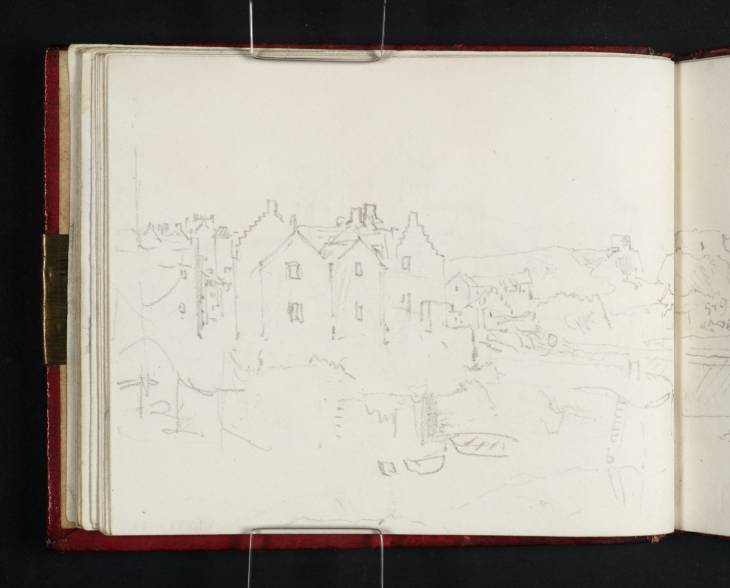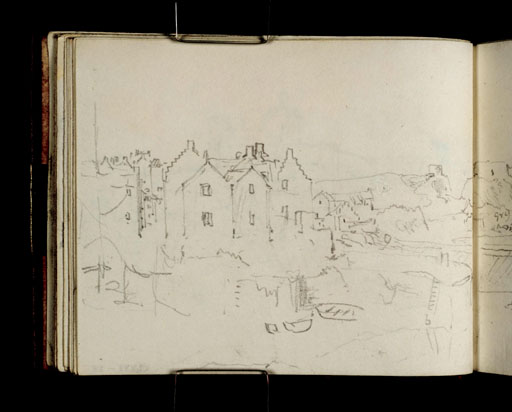Joseph Mallord William Turner Dunbar 1818
Image 1 of 2
Joseph Mallord William Turner,
Dunbar
1818
Joseph Mallord William Turner 1775–1851
Folio 18 Verso:
Dunbar 1818
D13484
Turner Bequest CLXVI 18a
Turner Bequest CLXVI 18a
Pencil on white wove paper, 90 x 112 mm
Accepted by the nation as part of the Turner Bequest 1856
References
1909
A.J. Finberg, A Complete Inventory of the Drawings of the Turner Bequest, London 1909, vol.I, p.482, CLXVI 18a, as ‘Dunbar.’.
Over two pages Turner has drawn Dunbar Harbour with the town on the left, the quay in the foreground, and the ruined castle on the right (see folio 19; D13485). Small boats can be seen moored up at the bottom left with a mast framing the composition, and the bow of a vessel is just visible next to the corner of the quayside at the bottom right. The building with crow-stepped gables is familiar from a sketch of the harbour in the Bass Rock and Edinburgh sketchbook (Tate D13366; Turner Bequest CLXV 24a). Dunbar, circa 1823 (watercolour, private collection),1 was one of the subjects that Turner was commissioned to illustrate for the Provincial Antiquities, and this viewpoint is close to the sketch on folios 24 verso to 25 (D13496–D13497), upon which the design was partially based.
A comparison between this sketch and some of the sketches of Dunbar in the Bass Rock and Edinburgh sketchbook demonstrates the different purposes that the two sketchbooks served on Turner’s tour of Scotland in 1818. A sketch of Dunbar, with the Harbour and Castle; the Cheviot Hills in the Distance (folio 24; Tate D13365; Turner Bequest CLXV 24) in the Bass Rock and Edinburgh sketchbook, for example shows objects and topographical features in outline alone with minimal details, no shading and no indication of tone or colour, while this sketch of Dunbar employs more details of architecture, topography, and local atmosphere, as well as employing shading. It is also more carefully and precisely drawn. As one or more than a dozen sketches of the castle, town and nearby coast, the Bass Rock and Edinburgh sketch functions as a rapid topographical and factual notation, or as a quick compositional experiment, while many of the sketches in the Edinburgh, 1818 sketchbook such as this one, have the potential to be used as the basis of a composition. There are, however, many drawings in the Edinburgh, 1818 sketchbook that are mere rapid notations and need to be seen alongside similar studies before they yield up much information.
Thomas Ardill
December 2007
How to cite
Thomas Ardill, ‘Dunbar 1818 by Joseph Mallord William Turner’, catalogue entry, December 2007, in David Blayney Brown (ed.), J.M.W. Turner: Sketchbooks, Drawings and Watercolours, Tate Research Publication, December 2012, https://www


